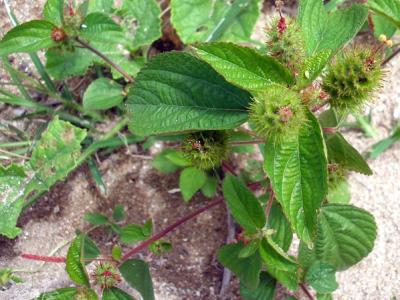(In territories with significant traditional TRAMIL use)
Guatemala:
- hierba del cáncer
leaves, decoction, local application1
According to the information available:
The use for skin infections is classified as REC based on the significant traditional use documented in the TRAMIL surveys and the scientific information published.
All topical application must follow strict hygiene measures that prevent contamination or additional infection.
If deterioration is observed in the patient or the skin infection persists for more than 5 days, seek medical attention.
Not for use during pregnancy, breastfeeding or in children under 3 years.
For skin infections:
prepare a decoction with 30 grams of leaves in 4 cups (1 litre) of water, boil for 5 minutes in an open vessel. Leave to cool and strain (filter). Wash the wound with boiled water and soap, apply the preparation in the form of washes or compresses on the affected area 3 times a day.
Preparations must never be stored for more than 24 hours, even if refrigerated.
1 GIRÓN LM, FREIRE V, ALONZO A, CÁCERES A, 1991
Encuesta TRAMIL (Costa atlántica). Ethnobotanical survey of the medicinal flora used by the Caribs of Guatemala. J Ethnopharmacol 34(2-3):173-187.
2 SOLÍS PN, RODRÍGUEZ N, ESPINOSA A, GUPTA MP, 2004
Estudio fitoquímico de algunas plantas TRAMIL con usos en Martinica. Informe TRAMIL. Centro de Investigaciones Farmacognósticas de la Flora Panameña CIFLORPAN, Facultad de Farmacia, Universidad de Panamá, Panamá, Panamá.
3 DUKE JA, 1992
Handbook of phytochemical constituents of GRAS herbs and other economic plants. Boca Raton, USA: CRC Press.
4 PERUMAL SAMY R, IGNACIMUTHU S, RAJA DP, 1999
Preliminary screening of ethnomedicinal plants from India. J Ethnopharmacol 66(2):235-240.
5 FREIXA B, VILA R, VARGAS L, LOZANO N, ADZET T, CANIGUERAL S, 1980
Screening for antifungal activity of nineteen Latin American plants. Phytother Res 12(6):427-430.
6 POULTON J, KEELER R, TU T, 1983
Cyanogenic compounds in plants and their toxic effects. In: Keeler R, Tu AT, Eds. Handbook of natural toxins, Vol 1: Plant and Fungal Toxins. New York, USA: Marcel Dekker p117-157.
7 NAHRSTEDT A, 1987
Recent developments in chemistry, distribution and biology of the cyanogenic glycosides. In: Hostettmann K, Lea PJ, Eds. Biologically Active Natural Products. Oxford, England: Oxford Science Publications. p167-184,213-234.
8 CARRICONDE C, CARRICONDE D, 1987
De volta às raízes. Impresos (periódicos) del Centro Nordestino de Medicina Popular de Recife, Brasil.
9 ARGEHEORE EM, AGUNBIADE OO, 1991
The toxic effects of cassava (Manihot esculenta Grants) diets on humans: a review. Hum Toxicol 33(3):273-275.


